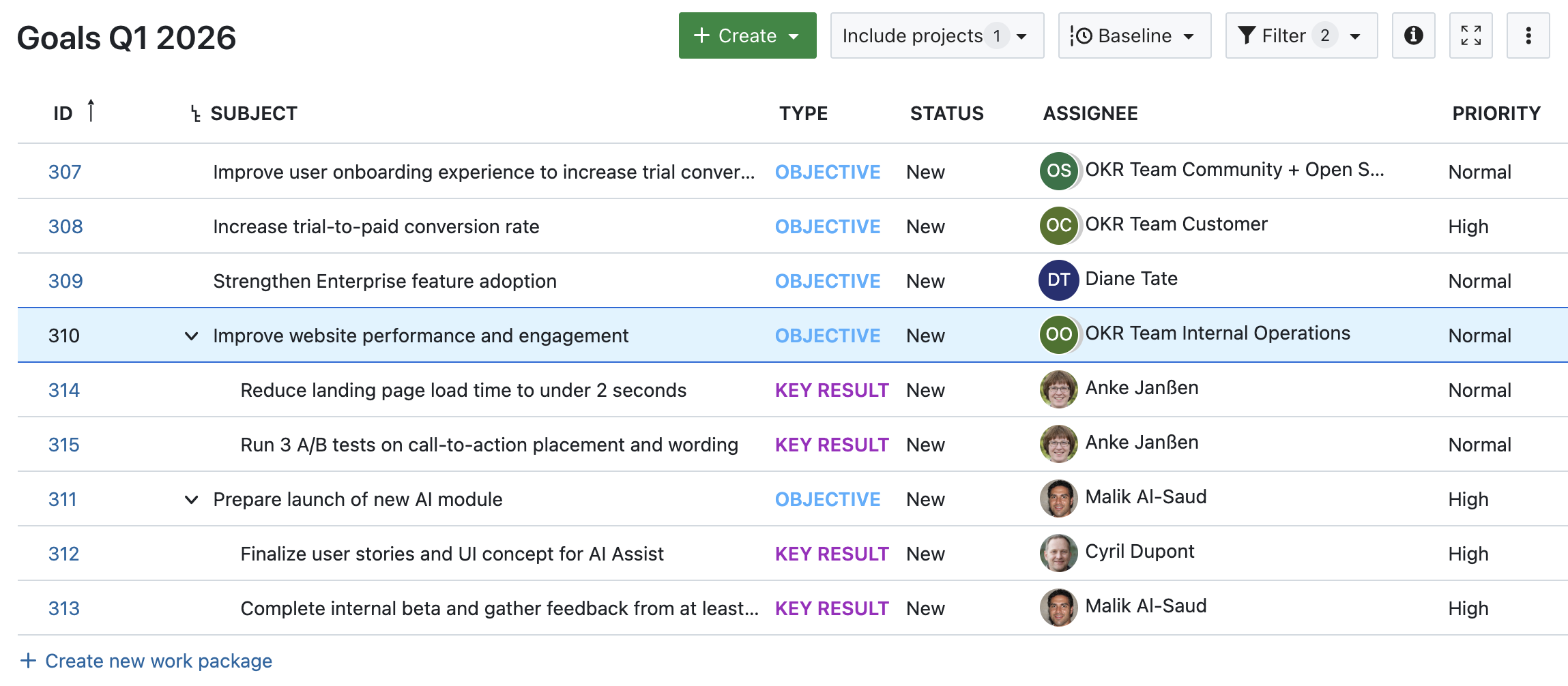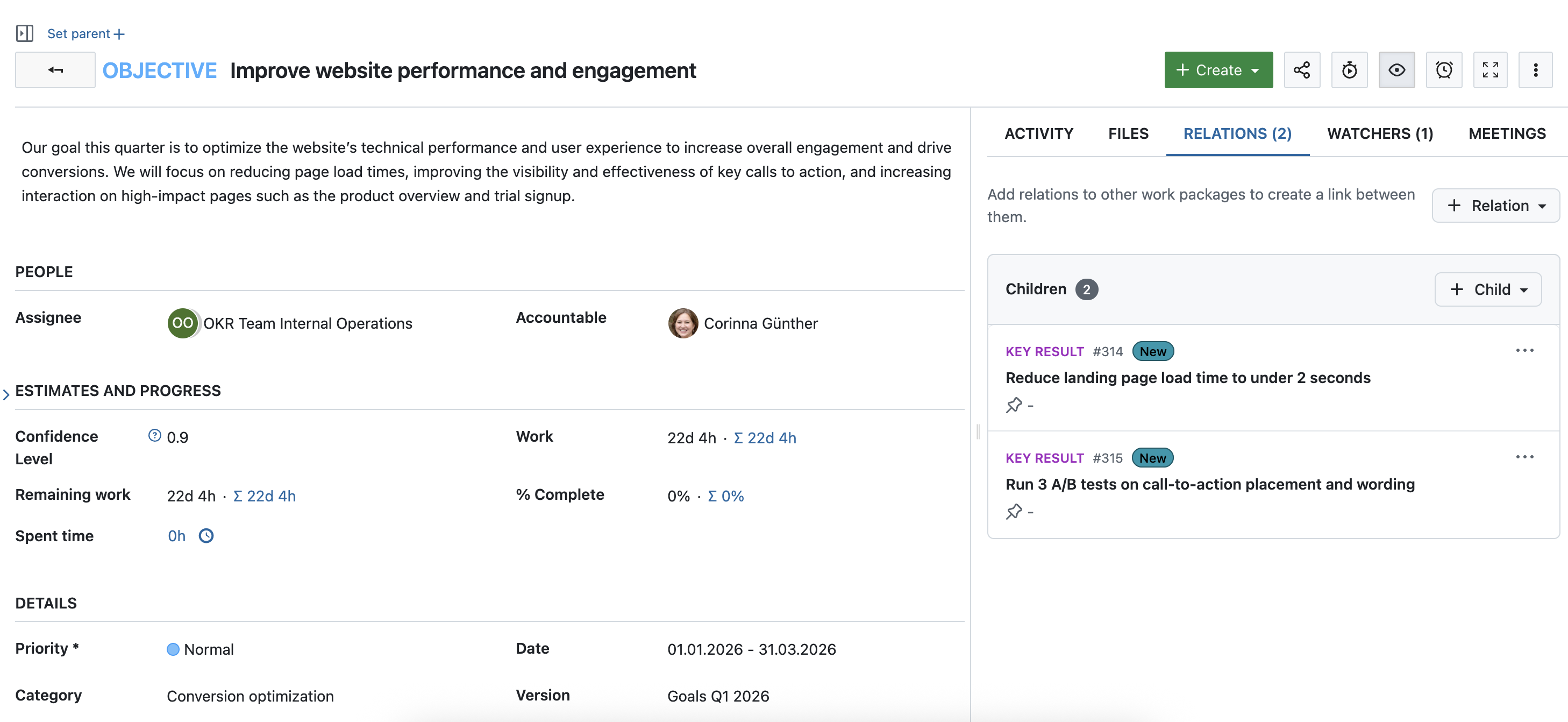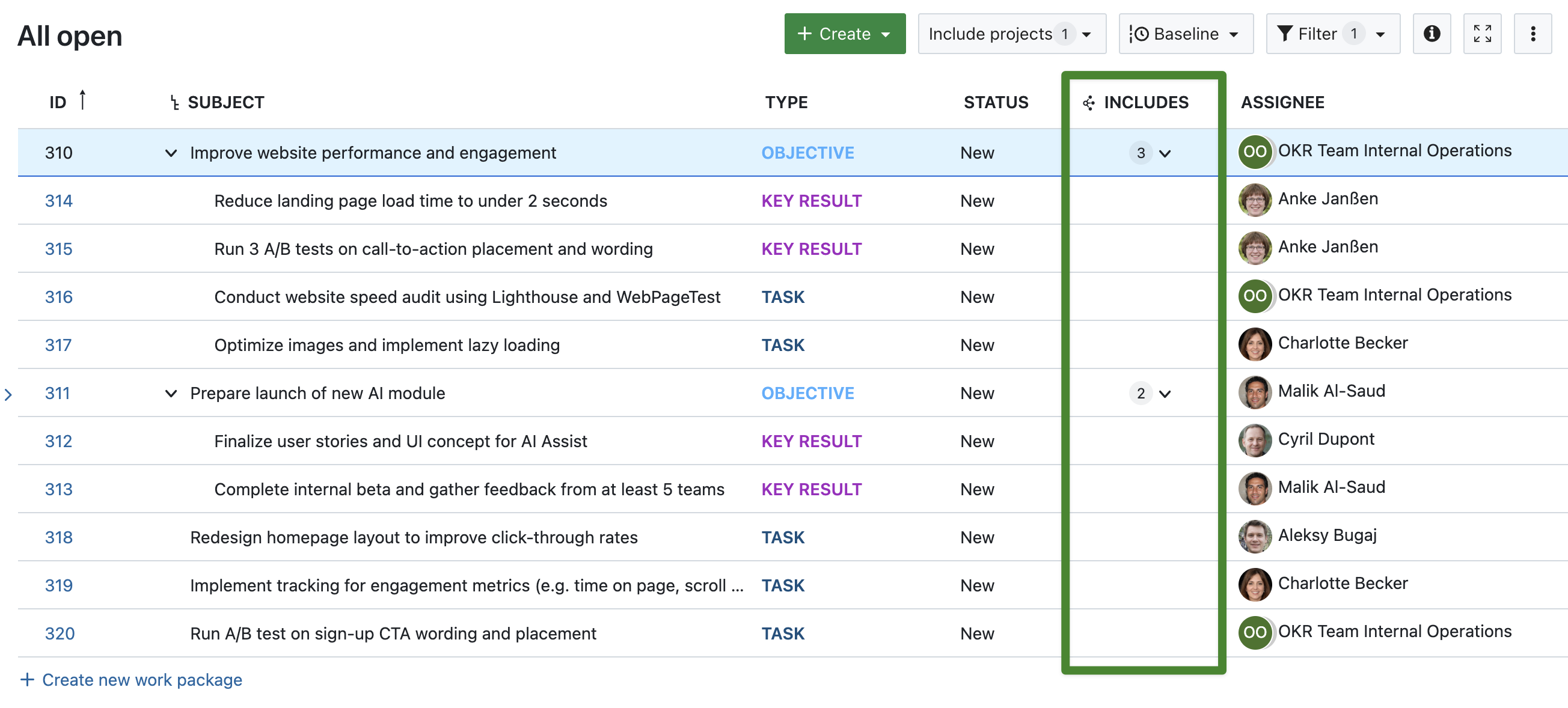Defina e atinja os seus objetivos com software de código aberto para OKRs (Objetivos e Resultados Chave)
O OpenProject, software seguro de gestão de projetos baseado na Web, suporta muitos casos de utilização diferentes. No início de cada trimestre, é muito conveniente seguir o processo OKR no OpenProject, definir os seus objetivos estratégicos, derivar objetivos mais pequenos e dividi-los em resultados mais pequenos, geríveis e mensuráveis.
O que são OKRs?
Depois do Agile, OKR tornou-se numa das palavras-chave mais reconhecidas na gestão empresarial moderna e na gestão de pessoas. Neste modelo de gestão, a empresa deixa de definir os objetivos apenas de cima para baixo, passando também a envolver os colaboradores na definição dos objetivos organizacionais.
OKR significa objetivos e resultados chave (Objectives and Key Results). Com os OKRs, as tarefas individuais dos colaboradores e/ou das equipas estão ligadas aos objetivos estratégicos da empresa. Com base nos objetivos da empresa, as equipas definem regularmente (por exemplo, todos os trimestres) os seus próprios objetivos — individuais ou de equipa — e estabelecem resultados mensuráveis para cada um deles.
Os objetivos são metas qualitativas: representam para onde se pretende ir ou o que se deseja alcançar, sempre em linha com os objetivos da empresa. Resultados-chave são resultados quantitativos mais pequenos (tarefas) que contam para o objetivo: O que tenho de fazer para atingir o objetivo, e como posso medi-lo?
Os objetivos globais da empresa são desdobrados em objetivos qualitativos e resultados-chave quantitativos para cada período de planeamento. O objetivo é alcançado quando todos os resultados-chave subjacentes estiverem concluídos.
OpenProject como software OKR de código aberto baseado na Web
Até nós utilizamos o OpenProject como software de OKR, para apoiar a nossa abordagem (ligeiramente adaptada) à metodologia OKR. Entre muitas outras funcionalidades, os objetivos podem ser facilmente definidos no OpenProject. Defina, documente e acompanhe os objetivos (estratégicos) da empresa. O módulo de pacotes de trabalho é muito adequado para o efeito. Primeiro, os tipos de pacotes de trabalho GOAL e KEY RESULT são adicionados e ativados no projeto.
Se necessário, pode adicionar campos personalizados adicionais, como Categoria de objetivo e KPI, ao tipo de pacote de trabalho. Recolha e especifique os objetivos (estratégicos) neste Backlog de Objetivos. Aqui é aconselhável subdividir, por exemplo, em diferentes categorias de objetivos. Durante o planeamento de objetivos, defina prioridades no OpenProject, atribua cada objetivo a um responsável e associe-o a uma versão (por exemplo, Objetivos Q1 2026).

Para o planeamento do trimestre seguinte, defina um filtro, por exemplo, para a versão “Objetivos Q1 2026”. Pode discutir estas metas estratégicas com a equipa e com cada responsável, depois dividi-las em metas qualitativas individuais (Objetivos) para o período seguinte e associar-lhes resultados-chave mensuráveis.
Isto funciona muito bem no OpenProject através da funcionalidade de relações. Escolha a relação “Inclui” entre o objetivo e os respetivos resultados-chave ou adicione resultados-chave como filhos dos objetivos.

Na lista, pode então ver quais os resultados-chave que têm de ser concluídos para cumprir o objetivo. Naturalmente, todas as outras caraterísticas dos pacotes de trabalho, tais como comentários, estado, prioridade, %Complete, campos personalizados, fluxos de trabalho, etc., funcionam para além disto.
Se definir os resultados-chave como filhos, pode criar uma relação “Parte de” entre as tarefas e o objetivo. Ou, em alternativa, adicione a relação “Inclui” ao Objetivo.

Assim, pode configurar o processo OKR conforme as suas necessidades. Isto permite uma documentação clara e eficiente, facilita o acompanhamento dos OKRs e possibilita a integração direta com a gestão de projetos.
Dica
Na equipa do OpenProject, utilizamos o nosso próprio software para gerir o trabalho sob a forma de Objectivos e Resultados Chave. Leia este guia para beneficiar das nossas aprendizagens sobre como utilizar o OpenProject como software OKR.
O que mais deve ter em conta quando trabalha com OKRs?
É preferível começar com poucos objectivos. Deve discutir de forma clara, na empresa ou na equipa, os pontos que quer focar no próximo trimestre.
Os principais resultados devem ser discriminados e documentados com o máximo de pormenor possível. Deve incluir um resultado mensurável, para saber exatamente quando o objetivo foi alcançado. Se necessário, pode trabalhar com o campo %Complete no OpenProject para mostrar o quão longe está de alcançar cada resultado-chave, e para ver o progresso ao longo do tempo.
A equipa deve chegar a consenso sobre se os objetivos são ambiciosos ou fixos, ou seja, objetivos que podem ser realisticamente atingidos até ao final do período. De qualquer forma, deve ser SMART. Leia mais sobre a definição de objetivos neste artigo da wikipedia.
Se um objetivo não puder ser alcançado num determinado período, procuramos dividi-lo em iterações menores sempre que possível. Se tal não for possível, aceitamos que um objetivo possa ser transferido para o período seguinte, incluindo novos resultados-chave.
Evidentemente, o software OKR só consegue apoiar o processo. É importante discutir os objetivos e os resultados em pormenor com a equipa, analisá-los em reuniões regulares e melhorá-los, se necessário. Recomenda-se uma revisão do processo e das lições aprendidas com a equipa no final de cada período de planeamento concluído, e antes do início da iteração seguinte.
Ficamos a aguardar o seu feedback, sugestões e ideias sobre a melhor forma de utilizar o OpenProject como software OKR.





